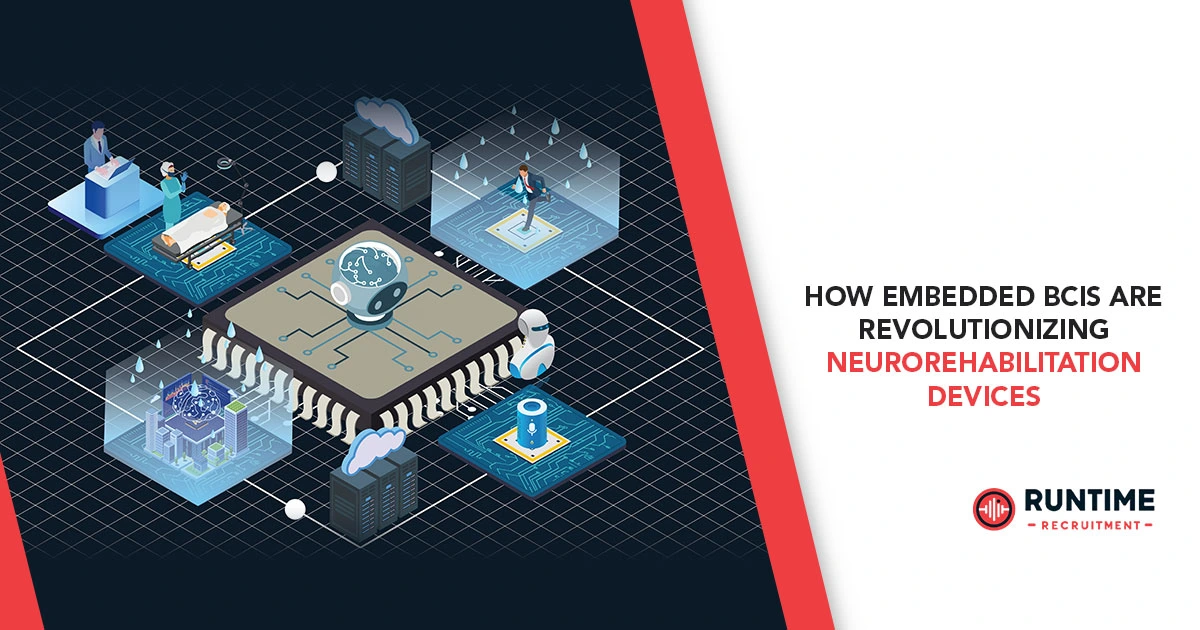The Dawn of a New Era in Neurorehabilitation
The field of neurorehabilitation stands at the precipice of a profound transformation, driven by the relentless march of technological innovation. For decades, individuals grappling with neurological impairments—whether from stroke, spinal cord injury, or neurodegenerative diseases—have faced arduous and often limited paths to recovery. Traditional rehabilitation, while vital, frequently encounters plateaus, leaving many with persistent functional deficits. However, a new paradigm is emerging, one where the power of thought directly interfaces with therapeutic devices, bypassing damaged neural pathways and unlocking unprecedented potential for recovery. This paradigm is Brain-Computer Interface (BCI) technology, specifically its embedded form, which is rapidly becoming the cornerstone of next-generation neurorehabilitation devices.
Embedded BCIs are not just an incremental improvement; they represent a fundamental shift in how we approach neurological repair and functional restoration. By establishing a direct communication channel between the brain and external devices, these systems empower patients to actively participate in their own recovery in ways previously unimaginable. This article delves deep into the intricate world of embedded BCIs, exploring their foundational principles, the engineering marvels that make them possible, their revolutionary applications in neurorehabilitation, and the exciting future that lies ahead for both patients and the embedded engineers who build these life-changing technologies.
Understanding Brain-Computer Interfaces: The Mind-Machine Connection
At its core, a Brain-Computer Interface is a system that translates brain activity into commands for an external device. This direct communication pathway bypasses the body’s normal neuromuscular output, offering a lifeline to individuals with severe motor disabilities. While the concept might sound like science fiction, the underlying principles are firmly rooted in neuroscience and engineering.
The Foundation: How BCIs Work
The journey from thought to action via a BCI involves several critical steps:
- Brain Signal Acquisition: The first and most crucial step is capturing the electrical activity of the brain. Neurons communicate through electrical impulses, and these impulses generate measurable fields. This can be achieved through various methods:
- Electroencephalography (EEG): The most common non-invasive method, EEG involves placing electrodes on the scalp to detect electrical potentials. It offers good temporal resolution (changes over time) but limited spatial resolution (pinpointing the exact brain area).
- Electrocorticography (ECoG): A semi-invasive technique where electrodes are placed directly on the surface of the brain, beneath the dura mater. ECoG provides higher spatial resolution and signal-to-noise ratio compared to EEG.
- Intracortical Arrays: Fully invasive, these involve implanting microelectrode arrays directly into the brain tissue. They offer the highest spatial resolution and signal fidelity, allowing for the recording of individual neuron firing. While promising for research and severe cases, their invasiveness presents challenges.
- Other Modalities: Functional Near-Infrared Spectroscopy (fNIRS) and functional Magnetic Resonance Imaging (fMRI) are also used in BCI research, though less commonly for real-time control due to their slower temporal resolution or bulky nature.
- Signal Preprocessing: Raw brain signals are inherently noisy, containing artifacts from muscle movements, eye blinks, and environmental interference. Preprocessing techniques—such as filtering, noise reduction, and artifact removal—are essential to isolate the relevant brain signals. This stage is critical for improving the signal-to-noise ratio and ensuring the quality of the data for subsequent analysis.
- Feature Extraction: Once cleaned, the signals are analyzed to extract specific features that correlate with the user’s intended commands. For example, in motor imagery (imagining moving a limb), specific changes in brainwave patterns (e.g., event-related desynchronization/synchronization in mu and beta rhythms) can be identified. Other features might include amplitude, frequency components, or event-related potentials (ERPs) in response to specific stimuli. This is where advanced digital signal processing (DSP) algorithms come into play.
- Feature Translation/Classification: The extracted features are then fed into a classification algorithm, often based on machine learning. This algorithm translates the brain patterns into specific commands for the external device. Common classification algorithms include linear discriminant analysis (LDA), support vector machines (SVMs), and deep learning neural networks. The system learns to differentiate between different mental states or intentions (e.g., “move arm left” vs. “move arm right”) and maps them to device controls.
- Device Control: Finally, the decoded commands are sent to the external neurorehabilitation device, whether it’s a robotic exoskeleton, a functional electrical stimulation (FES) system, or a virtual reality environment. This closed-loop system allows the user to receive real-time feedback, enabling them to refine their mental strategies and improve BCI control.
The “Embedded” Advantage
The “embedded” aspect of these BCIs is what makes them truly transformative for practical neurorehabilitation. Instead of bulky, lab-based setups requiring powerful external computers, embedded BCIs integrate all necessary components—signal acquisition, processing, classification, and device control—into a compact, often wearable, and self-contained unit.
Key characteristics of embedded BCIs:
- Miniaturization: Small form factor, often wearable or integrated directly into the rehabilitation device.
- Low Power Consumption: Designed for extended battery life, crucial for portable applications.
- Real-Time Processing: High-speed processing capabilities to ensure immediate response to brain signals.
- Robustness and Reliability: Built to withstand real-world conditions outside of a controlled lab environment.
- Autonomy: Operates independently without constant connection to external computing resources.
- Cost-Effectiveness: Aims to be affordable for wider adoption in clinical and home settings.
These characteristics are not merely technical specifications; they are critical enablers for bringing BCI technology out of the research lab and into the hands of patients, revolutionizing the accessibility and effectiveness of neurorehabilitation.
Engineering Marvels: The Core Components of Embedded BCIs
The development of embedded BCIs is an interdisciplinary feat, blending neuroscience, advanced signal processing, machine learning, and sophisticated embedded systems engineering. Embedded engineers play a pivotal role in transforming complex algorithms and research prototypes into robust, efficient, and user-friendly medical devices.
Hardware Architecture: The Brains and Brawn
The hardware of an embedded BCI is meticulously designed to optimize performance, power efficiency, and form factor.
- Bio-Signal Amplification and Digitization:
- Low-Noise Amplifiers: Brain signals are in the microvolt range, requiring ultra-low-noise amplifiers to boost their strength without introducing significant interference.
- Analog-to-Digital Converters (ADCs): These convert the continuous analog brain signals into discrete digital data, making them compatible with microcontrollers and digital signal processors. High sampling rates and resolution are crucial here.
- Microcontrollers/DSPs/FPGAs:
- Microcontrollers (MCUs): Often serve as the central processing unit, managing data flow, communication, and basic control logic. They are chosen for their low power consumption and integrated peripherals.
- Digital Signal Processors (DSPs): Specialized processors optimized for high-speed, repetitive mathematical operations, making them ideal for signal filtering, feature extraction, and real-time classification algorithms.
- Field-Programmable Gate Arrays (FPGAs): Offer unparalleled flexibility and parallel processing capabilities, particularly useful for custom hardware acceleration of complex algorithms or managing multiple high-bandwidth sensor inputs simultaneously.
- Memory:
- RAM (Random Access Memory): For temporary storage of signal data, intermediate processing results, and program variables.
- Flash Memory: For storing firmware, configuration parameters, and pre-trained machine learning models.
- Power Management Unit (PMU):
- Essential for regulating power from batteries, optimizing energy consumption across different components, and managing charging cycles. This is critical for portable devices.
- Wireless Communication Modules:
- Bluetooth Low Energy (BLE), Wi-Fi, or proprietary RF: For wirelessly transmitting processed commands to external devices (e.g., a robotic hand, a computer for data logging) or for receiving updates and configurations.
- Sensors (Beyond EEG/ECoG):
- Inertial Measurement Units (IMUs): Often integrated into rehabilitation devices to provide feedback on limb position and movement, augmenting BCI control.
- Force Sensors: To measure interaction forces with the environment.
Software and Firmware: The Intelligence
The software and firmware layers are where the raw hardware is brought to life, enabling intelligent interaction and adaptive learning.
- Embedded Operating System (RTOS):
- A Real-Time Operating System (RTOS) is often employed to ensure predictable timing and efficient management of concurrent tasks, which is vital for real-time BCI operation.
- Signal Processing Libraries:
- Optimized libraries for filtering (e.g., Butterworth, FIR, IIR), artifact removal (e.g., independent component analysis – ICA), and feature extraction (e.g., spectral analysis, wavelet transforms). These are often hand-tuned for the specific DSP or MCU architecture.
- Machine Learning Frameworks (Lightweight):
- Deployment of pre-trained machine learning models (e.g., SVMs, simple neural networks) specifically optimized for embedded inference. This involves techniques like model quantization and pruning to reduce memory footprint and computational requirements.
- The ability to perform online learning or adaptive algorithms is also crucial, allowing the BCI to continuously learn and improve its performance as the user’s brain signals evolve over time or as they gain more proficiency.
- Communication Protocols:
- Implementation of robust communication protocols (e.g., UART, SPI, I2C for internal components; BLE, TCP/IP for external) to ensure seamless data exchange.
- User Interface (If applicable):
- Simple interfaces for configuration, calibration, and feedback, possibly via a small display or LED indicators, or through a connected smartphone app.
Challenges and Innovations for Embedded Engineers
Developing these systems presents unique challenges for embedded engineers:
- Power Optimization: Balancing computational power with stringent battery life requirements. Innovative low-power design techniques, dynamic voltage and frequency scaling (DVFS), and efficient sleep modes are essential.
- Real-Time Constraints: Ensuring minimal latency between brain signal detection and device response. This requires careful scheduling, optimized algorithms, and efficient hardware utilization.
- Miniaturization and Heat Dissipation: Packing complex electronics into a small, wearable form factor while managing thermal performance.
- Reliability and Robustness: Designing for medical-grade reliability, fault tolerance, and resilience to environmental factors (temperature, humidity, EMI).
- Security and Privacy: Protecting sensitive patient data and ensuring the integrity of the BCI system.
- Regulatory Compliance: Navigating complex medical device regulations (e.g., FDA, CE Mark) which impact every stage of design and development.
- Human-Computer Interaction (HCI): Designing intuitive calibration procedures and feedback mechanisms that are easy for patients with neurological impairments to understand and use. This often involves close collaboration with neuroscientists and physical therapists.
Embedded engineers are at the forefront of addressing these challenges, constantly pushing the boundaries of what’s possible in miniature, low-power, high-performance computing to bring these life-changing technologies to fruition.
Revolutionary Applications in Neurorehabilitation
The integration of embedded BCIs into neurorehabilitation devices is creating a paradigm shift, moving beyond traditional methods to leverage the brain’s inherent plasticity and the patient’s active mental engagement.
Stroke Rehabilitation: Rewiring the Brain
Stroke is a leading cause of long-term disability, often resulting in hemiparesis (weakness on one side of the body). Embedded BCIs are revolutionizing stroke rehabilitation in several ways:
- Motor Imagery-Based Rehabilitation: Patients are trained to imagine moving their affected limb. The BCI detects these motor imagery signals and uses them to control a rehabilitation device, such as a robotic hand exoskeleton or a functional electrical stimulation (FES) system. This creates a “closed loop” where the patient’s intent (thought) is translated into actual movement (via the device), providing crucial sensory feedback. This repetitive, goal-oriented practice helps to rewire neural pathways in the brain, a process known as neuroplasticity.
- Example: A patient imagines opening their paralyzed hand. The BCI detects the specific brain pattern, and a robotic glove opens the patient’s hand. This synchronized sensory input reinforces the brain’s motor command.
- Advantages: Engages the patient’s active participation, promotes cortical reorganization, and can be used even by patients with very limited residual movement.
- Functional Electrical Stimulation (FES) Integration: BCIs can directly trigger FES, which applies electrical impulses to muscles to generate movement. For stroke patients, a BCI-controlled FES can help re-educate muscles, improve gait, and restore grasp function. The BCI acts as a “neural bypass,” allowing the brain’s intention to directly activate the paralyzed muscles.
- Virtual Reality (VR) and Augmented Reality (AR) Environments: Embedded BCIs can control avatars or objects within VR/AR environments, making rehabilitation exercises more engaging and immersive. Patients can practice complex movements in a safe, simulated environment, with the BCI providing direct control and the VR system offering rich visual and auditory feedback.
- Benefits: Increased motivation, ability to simulate real-world scenarios, and precise tracking of progress.
Spinal Cord Injury (SCI): Restoring Movement and Independence
For individuals with SCI, embedded BCIs offer hope for regaining lost motor function and increasing independence.
- Exoskeletons and Prosthetics Control: Perhaps one of the most visible applications, BCIs allow individuals with complete paralysis to control advanced robotic exoskeletons or prosthetic limbs. By thinking about moving a limb, the BCI translates these thoughts into commands that actuate the robotic device, enabling walking, reaching, and grasping.
- Technological Advancement: The move from wired, lab-based systems to compact, wearable embedded BCIs is making these devices more practical for daily use.
- Assistive Communication Devices: Beyond motor control, BCIs can also be used for communication in patients with severe speech impairments (e.g., locked-in syndrome due to SCI). By controlling virtual keyboards or selection interfaces with their thoughts, patients can communicate with the outside world.
- Bladder and Bowel Control (Emerging): Research is ongoing into using BCIs to restore autonomic functions, such as bladder and bowel control, which are often compromised in SCI and significantly impact quality of life. This involves more complex BCI paradigms and often invasive electrode placement.
Neurodegenerative Diseases (e.g., Parkinson’s, ALS): Maintaining Function and Quality of Life
While not curative, embedded BCIs can significantly enhance the quality of life and maintain functional independence for patients with progressive neurodegenerative diseases.
- ALS (Amyotrophic Lateral Sclerosis): As ALS progresses, patients lose the ability to move and speak. BCIs become a critical tool for communication, allowing patients to control assistive devices (e.g., communication aids, smart home systems) using only their thoughts.
- Impact: Empowers patients to maintain agency and connection with their environment long after motor function is lost.
- Parkinson’s Disease: While deep brain stimulation (DBS) is a common treatment for Parkinson’s, research is exploring BCI interfaces for more adaptive, thought-controlled adjustments to DBS parameters, or for controlling external devices to aid with tremors or gait difficulties.
Phantom Limb Pain Management: A Novel Approach
Embedded BCIs are also being explored for managing phantom limb pain, a debilitating condition experienced by many amputees. By allowing amputees to control a virtual or robotic limb with their thoughts, it can provide visual and proprioceptive feedback that helps to alleviate the sensation of pain in the missing limb. This “re-embodiment” can trick the brain into believing it is controlling the limb, thereby reducing the neuropathic pain signals.
Mental Health and Cognitive Rehabilitation (Future Directions)
While still nascent, the potential for embedded BCIs in mental health and cognitive rehabilitation is immense.
- Attention Training: BCI games and exercises could help individuals with ADHD improve focus and attention.
- Memory Enhancement: Direct neural stimulation guided by BCI signals could potentially aid in memory consolidation or retrieval for conditions like early-stage Alzheimer’s.
- Biofeedback for Anxiety/Depression: Real-time feedback on brain states could help individuals learn to self-regulate anxiety or depressive patterns.
The versatility of embedded BCI technology means its impact will continue to expand, touching upon an ever-broader spectrum of neurological conditions and offering new avenues for therapeutic intervention.
Challenges and the Road Ahead for Embedded BCIs
Despite their immense promise, embedded BCIs face significant challenges that require continuous innovation from multidisciplinary teams, with embedded engineers at the forefront.
Technical Hurdles: Pushing the Boundaries of Engineering
- Signal Quality and Reliability: Non-invasive EEG can be noisy and susceptible to artifacts. Improving signal acquisition, especially in real-world, non-clinical environments, is paramount. Developing more comfortable, user-friendly, and dry electrode systems is an ongoing area of research. For invasive BCIs, long-term stability and biocompatibility of implants are critical.
- Algorithm Robustness and Adaptability: Brain signals are highly variable across individuals and even within the same individual over time. BCI algorithms need to be robust to these variations, capable of rapid calibration, and adapt continuously to changes in brain activity (e.g., due to fatigue, learning, or disease progression). This necessitates more sophisticated, lightweight machine learning models suitable for embedded deployment.
- Battery Life and Power Efficiency: For wearable and portable devices, maximizing battery life while maintaining high computational performance is a perpetual challenge. Innovations in ultra-low-power processors, energy harvesting, and efficient power management are crucial.
- Miniaturization and Ergonomics: Devices need to be small, lightweight, and comfortable for prolonged use. Integrating all necessary components (electrodes, amplifiers, processors, batteries, wireless modules) into discreet and aesthetically acceptable forms is a major design challenge.
- Latency Reduction: For intuitive control, the delay between a thought and the device’s response must be minimal. Optimizing every stage of the BCI pipeline, from signal acquisition to command execution, is vital.
Clinical and User-Centric Challenges: Bridging the Gap
- User Training and Adoption: Learning to control a BCI effectively requires training, patience, and mental effort. Developing intuitive training protocols and engaging feedback mechanisms (e.g., gamification) is essential for patient adherence and success.
- Ethical Considerations: As BCIs become more sophisticated, ethical questions around data privacy, agency, identity, and potential “mind reading” capabilities (though far off) will become increasingly important.
- Regulatory Approval: As medical devices, BCIs must undergo rigorous testing and meet stringent regulatory standards, which can be a lengthy and costly process.
- Cost and Accessibility: For widespread adoption, embedded BCI devices need to be affordable. This requires cost-effective manufacturing processes and sustainable business models.
- Integration into Clinical Practice: Seamless integration into existing neurorehabilitation workflows, including training for clinicians and therapists, is vital for successful implementation.
The Role of Embedded Engineers in the Future
Embedded engineers are not just implementers; they are innovators driving the future of neurorehabilitation. Their expertise is critical in:
- Designing Next-Generation Hardware: Developing custom ASICs (Application-Specific Integrated Circuits) for ultra-low-power BCI processing, integrating advanced sensor technologies, and creating modular, scalable hardware platforms.
- Optimizing Algorithms for the Edge: Porting complex neuroscience algorithms and AI models to resource-constrained embedded systems, developing real-time adaptive learning frameworks, and ensuring algorithmic efficiency.
- Ensuring Robustness and Reliability: Building fail-safe mechanisms, implementing rigorous testing protocols, and designing for long-term operational stability in demanding environments.
- Improving User Experience: Collaborating with designers and clinicians to create ergonomic, intuitive, and engaging devices that empower users.
- Navigating Regulatory Landscapes: Understanding and implementing medical device standards from the ground up to ensure safety and efficacy.
The future will see even smaller, more powerful, and more intelligent embedded BCIs. Innovations like dry electrodes that require no skin preparation, completely implantable wireless systems, and BCIs integrated with smart textiles or adaptive robotics are on the horizon. The convergence of neurotechnology with AI and advanced robotics will unlock unprecedented levels of functional restoration and independence for individuals with neurological impairments.
Conclusion: A Future Empowered by Thought
Embedded Brain-Computer Interfaces represent more than just advanced technology; they embody a profound hope for millions worldwide. By bridging the gap between intention and action, these devices are not merely assisting; they are actively rehabilitating, leveraging the brain’s innate capacity for change. The journey from rudimentary thought control to sophisticated, wearable neurorehabilitation systems has been an incredible testament to human ingenuity.
The impact of embedded BCIs extends beyond physical recovery. They offer psychological liberation, restoring agency, connection, and dignity to individuals who might otherwise face a lifetime of dependence. As these technologies continue to evolve, fueled by relentless research and the groundbreaking work of dedicated engineers, we can envision a future where neurological impairment no longer dictates the limits of human potential.
The revolution in neurorehabilitation is here, and it’s being built, byte by byte and circuit by circuit, by the brilliant minds in embedded systems engineering. Their work is quite literally empowering thought to reshape lives.
Connect with RunTime Recruitment
Are you an embedded engineer passionate about making a real-world impact with cutting-edge technology?
RunTime Recruitment specializes in connecting top-tier embedded systems talent with pioneering companies in neurotechnology and medical devices. Explore exciting opportunities to shape the future of neurorehabilitation.
Connect with RunTime Recruitment today to find your next challenging role!









